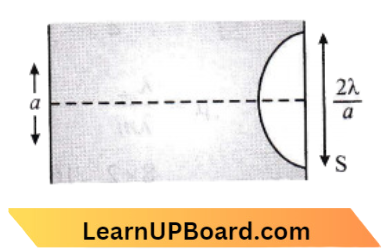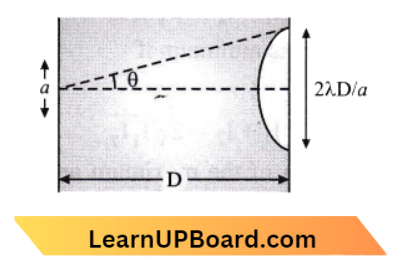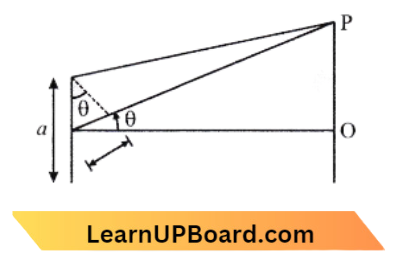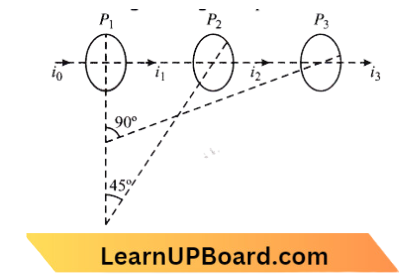Wave Optics MCQs For NEET
NEET Physics For Wave Optics Multiple Choice Questions
Question 1. In Young’s double slit experiment, a student observed 8 fringes in a certain segment of the screen when a monochromatic light of 600 nm wavelength is used. If the wavelength of light is changed to 400 nm, then the number of fringes he would observe in the same region of the screen is
- 6
- 8
- 9
- 12
Answer: 4. 12
Given
In a Young’s double slit experiment, a student observed 8 fringes in a certain segment of the screen when a monochromatic light of 600 nm wavelength is used. If the wavelength of light is changed to 400 nm
The wavelength of light is inversely proportional to the number of fringes observed
So, \(n_1 \lambda_1 =n_2 \lambda_2\)
∴ \(n_2=\frac{n_1 \lambda_1}{\lambda_2}\)
= \(\frac{600 \times 8}{400}=12\)
Question 2. Two coherent sources of light interfere and produce a fringe pattern on a screen. For central maximum, the phase difference between the two waves will be
- Zero
- \(\pi\)
- \(\frac{3 \pi}{2}\)
- \(\frac{\pi}{2}\)
Answer: 1. Zero
From Young’s double slit experiment phase difference = \(\frac{2 \pi}{\lambda}\) x path difference. But for central maximum, path difference is zero for both coherent sources in interference.
Which means the path difference = 0
Phase difference = \(\frac{2 \pi}{\lambda}\) x 0 = 0
Wave Optics MCQs for NEET
Question 3. In Young’s double-slit experiment, if the separation between coherent sources is halved and the distance of the screen from the coherent sources is doubled, then the fringe width becomes
- Half
- Four times
- One fourth
- Double
Answer: 2. Four times
Given
In Young’s double-slit experiment, if the separation between coherent sources is halved and the distance of the screen from the coherent sources is doubled,
From Young’s double slit experiment fringe width
⇒ \(\beta =\frac{\lambda D}{d}\)
⇒ \(\frac{\beta_2}{\beta_1} =\frac{\frac{\lambda_2 D_2}{d_2}}{\frac{\lambda_1 D_1}{d_1}}\)
Given, \(\lambda_1=\lambda_2, D_2=2 D_1\), and \(d_2=\frac{d_1}{2}\) putting these values in above equation,
⇒ \(\frac{\beta_2}{\beta 1}=\overline{\left(\frac{2 D_1}{2}\right)} \times \frac{d_1}{\mathrm{D}_1}=4\)
⇒ \(\beta_2=4 \beta_1\)
Fringe width becomes four times.
Read and Learn More NEET Physics MCQs
Question 4. In a double slit experiment, when light of wavelength 400 nm was used, the angular width of the first minima formed on a screen placed 1 m away, was found to be 0.2°. What will be the angular width of the first minima, if the entire experimental apparatus is immersed in water? (μ water = 4/3)
- 0.15°
- 0.051°
- 0.1°
- 0.266°
Answer: 1. 0.15°
Given
In a double slit experiment, when light of wavelength 400 nm was used, the angular width of the first minima formed on a screen placed 1 m away, was found to be 0.2°.
Angular width, \(\theta=0.2^{\circ}\)
Now, \(\theta=\frac{\beta}{D}=0.2^{\circ}\)
In water, \(\theta^{\prime}=\frac{\beta}{\mu D}\)
⇒ \(\theta^{\prime}=\frac{\theta}{\mu}=\frac{0.2}{4 / 3}\)
= \(0.15^{\circ}\)
Question 5. In Young’s double slit experiment, if there is no initial phase difference between the light from the two slits, a point on the screen corresponding to the fifth minimum has a path difference
- \(5 \frac{\lambda}{2}\)
- \(10 \frac{\lambda}{2}\)
- \(9 \frac{\lambda}{2}\)
- \(11 \frac{\lambda}{2}\)
Answer: 3. \(9 \frac{\lambda}{2}\)
In young’s double slit experiment \(\Delta x=\text { path difference }=(2 n-1) \frac{\lambda}{2}\)
So, Here n=5 means for \(5^{\text {th }}\) minima
∴ \(\Delta x=(2 \times 5-1) \frac{\lambda}{2}=\frac{9}{2} \lambda\)
MCQs on Wave Optics for NEET
Question 6. In Young’s double slit experiment, the separation d between the slits is 2 mm, the wavelength X of the light used is 5896 Å and distance D between the screen and slits is 100 cm. It is found that the angular width of the fringes is 0.20°. To increase the fringe angular width to 0.21° (with the same λ and D) the separation between the slits needs to be changed to
- 2.1 mm
- 1.9 mm
- 1.8 mm
- 1.7 mm
Answer: 2. 1.9 mm
Given
In Young’s double slit experiment, the separation d between the slits is 2 mm, the wavelength X of the light used is 5896 Å and distance D between the screen and slits is 100 cm. It is found that the angular width of the fringes is 0.20°.
In Young’s Double slit experiment Angular width of fringe is \(\theta=\frac{\lambda}{d}\)
⇒ \(\theta \propto \frac{1}{d}\)
or \(\frac{\theta_1}{\theta_2}=\frac{d_2}{d_1}\)…..(1)
In question, \(\theta_1=0.21^{\circ}\)
⇒ \(d_1=2 \mathrm{~mm}\)
Then eq. (1) becomes, \(\frac{0.20^{\circ}}{0.21^{\circ}}=\frac{d_2}{2 \mathrm{~mm}}\)
⇒ \(d_2=2 \times \frac{0.20}{0.21}=\frac{0.40}{0.21}\)
= \(1.90 \mathrm{~mm}\)
Question 7. Young’s double slit experiment is first performed in air and then in a medium other than air. It is found that the 5th dark fringe in the air is equal to the 8th bright fringe that lies in the medium. The refractive index of the medium is nearly :
- 1.25
- 1.59
- 1.69
- 1.78
Answer: 4. 1.78
Given
Young’s double slit experiment is first performed in air and then in a medium other than air. It is found that the 5th dark fringe in the air is equal to the 8th bright fringe that lies in the medium.
From the question, it is clear that 5th dark fringe in air = 8th bright fringe in medium
⇒ \((2 \times 5-1) \frac{\lambda_{\text {air }} D}{2 d}=8 \frac{\lambda_m D}{d}\)
⇒ \(9 \frac{\lambda_{\text {air }} D}{2 d}=8 \frac{\lambda_m D}{d}\)
⇒ \(\mu =\frac{\lambda_{\text {air }}}{\lambda m}\)
⇒ \(\mu =\frac{8 \times 2}{9}=\frac{16}{9}\)
Refractive index of medium \(\mu=\frac{16}{9} \cong 1.78\)
MCQs on Wave Optics for NEET
Question 8. The intensity at the maximum in Young’s double slit experiment is I0. The distance between slits is d = 5λ, where X is the wavelength of light used in the experiment. What will be the intensity in front of one of the slits on the screen placed at a distance D = 10d?
- \(\frac{\mathrm{I}_0}{4}\)
- \(\frac{3}{4} \mathrm{l}_0\)
- \(\frac{1_0}{2}\)
- \(\mathrm{I}_0\)
Answer: 3. \(\frac{1_0}{2}\)

= \(S_2 P-S_1 P\)
= \(\sqrt{D^2+d^2}-D\)
= \(D\left(1+\frac{1}{2} \frac{d^2}{D^2}\right)-D\)
= \(D\left[1+\frac{d^2}{2 D^2}-1\right]=\frac{d^2}{2 D}\)
Now \(\Delta x=\frac{d^2}{2 \times 10 d}=\frac{d}{20}\)
= \(\frac{5 \lambda}{20}=\frac{\lambda}{4}\)
⇒ \(\Delta \phi=\frac{2 \lambda}{\lambda} \cdot \frac{\lambda}{4}=\frac{\pi}{2}\)
⇒ \(\Delta \phi=\frac{2 \lambda}{\lambda}, \frac{\lambda}{4}=\frac{\pi}{2}\)
(because phase difference = \(\frac{2 \pi}{\lambda}\). path difference)
So, the intensity at the desired point is \(I=I_0 \cos ^2 \frac{\phi}{2}=I_0 \cos ^2 \frac{\pi}{4}=\frac{I_0}{2}\)
Question 9. The interference pattern is obtained with two coherent light sources of intensity ratio n. In the interference pattern, the ratio \(\frac{I_{\max }-I_{\min }}{I_{\max }+I_{\min }}\) will be:
- \(\frac{\sqrt{n}}{n+1}\)
- \(\frac{2 \sqrt{n}}{n+1}\)
- \(\frac{\sqrt{n}}{(n+1)^2}\)
- \(\frac{2 \sqrt{n}}{(n+1)^2}\)
Answer: 2. \(\frac{2 \sqrt{n}}{n+1}\)
Let [\(\frac{I_1}{I_2}=\frac{n}{1}\)
\(\frac{I_{\max }-I_{\min }}{I_{\max }+I_{\min }}\)= \(\frac{\left(\sqrt{I_1}+\sqrt{I_2}\right)^2-\left(\sqrt{I_1}-\sqrt{I_2}\right)^2}{\left(\sqrt{I_1}+\sqrt{I_2}\right)^2+\left(\sqrt{I_1}-\sqrt{I_2}\right)^2}\)
= \(\frac{4 \sqrt{I_1 I_2}}{2\left(I_1+I_2\right)}\)
Dividing numerator and denominator by 2.
Ratio will be \(\frac{\sqrt[2]{\frac{I_1}{I_2}}}{\left(\frac{I_1}{I_2}+1\right)}=\frac{2 \sqrt{n}}{n+1}\)
NEET Wave Optics Questions
Question 10. In a double-slit experiment, the two slits are 1 mm apart and the screen is placed 1 m away. A monochromatic light of wavelength 500 nm is used. What will be the width of each slit for obtaining ten maxima of double slit within the central maxima of a single slit pattern?
- 0.2 mm
- 0.1 mm
- 0.5 mm
- 0.02 mm
Answer: 1. 0.2 mm

Given : d = \(1 \mathrm{~mm}=1 \times 10^{-3} \mathrm{~m}\)
D = \(1 \mathrm{~m}\)
⇒ \(\lambda =5 \times 10^{-7} \mathrm{~m}\)
As width of central maxima = width of 10 maxima
⇒ \(\frac{2 \lambda D}{a}=10\left(\frac{\lambda D}{d}\right)\)
a = \(\frac{d}{5}=\frac{10^{-3}}{5}=0.2 \times 10^{-3} \mathrm{~m}\)
a = \(0.2 \mathrm{~mm}\)
Question 11. Two slits in Young’s experiment have widths in the ratio 1: 25. the ratio of intensity at the maxima and minima in the interference pattern \(\frac{I_{\max }}{I_{\min }}\) is
- 9/4
- 121/49
- 49/121
- 4/9
Answer: 1. 9/4
In Young’s double slit experiment, two slits of width are in the ratio 1: 25,
Ratio of intensity, \(\frac{I_1}{I_2}=\frac{W_1}{W_2}=\frac{1}{25}\)
⇒ \(\frac{I_2}{I_2}=\frac{1}{25}\)…..(1)
From the question, \(\frac{I_{\max }}{I_{\min }}=\frac{\left(\sqrt{I_2}+\sqrt{I_1}\right)^2}{\left(\sqrt{I_2}-\sqrt{I_1}\right)^2}\)
⇒ \(\frac{I_{\max }}{I_{\min }}=\left[\frac{\sqrt{\frac{I_2}{I_1}}+1}{\sqrt{\frac{I_2}{I_1}}-1}\right]^2\)
⇒ \(\frac{I_{\max }}{I_{\min }}=\left[\frac{5+1}{5-1}\right]^2\)
⇒ \(\frac{I_{\max }}{I_{\min }}=\frac{6^2}{4^2}\)
⇒ \(\frac{I_{\mathrm{mix}}}{I_{\min }}=\frac{36}{16}\)
∴ \(\frac{I_{\mathrm{mix}}}{I_{\min }}=\frac{9}{4}\)
Class 12 Wave Optics MCQs
Question 12. In Young’s double-slit experiment, the intensity of light at a point on the screen (where the path difference is A,) is K, (λ, being the wavelength of light used). The intensity a point where the path difference is λ/4, will be:
- K
- K/4
- K/2
- Zero
Answer: 3. K/2
We know that I = \(I_0 \cos ^2\left[\frac{k\left(r_1-r_2\right)}{2}\right]\)
and \(r_1-r_2 =I \Rightarrow I=K\)
K = \(I_0 \cos ^2\left[\frac{2 \pi}{\lambda} \times \frac{\lambda}{2}\right]\)
K = \(I_0 \cos ^2 \pi\)
K = \(I_0\)….(1)
( \(\cos ^2 \pi=(-1)^2=1\))
Now again, \(I=I_0 \cos ^2\left[\frac{k\left(r_1-r_2\right)}{2}\right]\)
and \(r_1-r_2=\frac{\pi}{4}\)
and \(K=\frac{2 \pi}{4}\)
I = \(I_2 \cos ^2\left[\frac{2 \pi}{\pi} \times \frac{\pi}{8}\right]\)
= \(I_0 \frac{\cos ^2(\pi)}{4}=\frac{I_0}{2}\)
(because \(I_0=K\) from eq. (1))
\(I=\frac{K}{2}\)Question 13. In Young’s double slit experiment, the slits are 2 mm apart and are illuminated by photons of two wavelengths λ1 = 12000A and λ2 = 10000 A. At what minimum distance from the common central bright fringe on the screen, 2 m from the slit will a bright fringe from one interference pattern coincide with a bright from the other?
- 8 mm
- 6 mm
- 4 mm
- 3 mm
Answer: 2. 6 mm
Given
In Young’s double slit experiment, the slits are 2 mm apart and are illuminated by photons of two wavelengths λ1 = 12000A and λ2 = 10000 A.
According to the question, \(n_1 \lambda_1=n_2 \lambda_2\)
So, \(\frac{n_1}{n_2}=\frac{\lambda_2}{\lambda_1}=\frac{10000}{12000}=\frac{5}{6}\)
So maximum \(n_1\) and \(n_2\) are 5 and 6 respectively
⇒ \(X_{m n}=\frac{n_1 \lambda_1 D}{d}=\frac{5\left(12000 \times 10^{-2}\right)(2)}{2 \times 10^{-3}}\)
= \(6 \times 10^{-3} \mathrm{~m}=6 \mathrm{~mm} .\)
Question 14. In Young’s double-slit experiment, the distance between the slits and the screen is doubled. The separation between the slits was reduced to half. As a result the fringe width:
- Is halved
- Becomes four times
- Remains unchanged
- Is doubled
Answer: 2. Becomes four times
In Young’s double slit experiment fringe width \(\beta=\frac{\lambda D}{d}\)…(1)
where, D = distance between slit and screen
d = distance between slit
According to the question, D is double → 2D and d is half → d/2
Their New fringe width will be \(\frac{\lambda \times 2 D}{\frac{d}{2}}=\frac{4 \lambda D}{d}=4\left(\frac{\lambda D}{d}\right)=\beta\)
[A = 4p i.e., becomes four times
Important MCQs on Wave Optics for NEET
Question 15. A lens of large focal length and large aperture is best suited as an objective of an astronomical telescope since:
- A large aperture contributes to the quality and visibility of the images.
- A large area of the objective ensures better light-gathering power.
- A large aperture provides a better resolution
- All of the above
Answer: 4. All of the above
A large focal length and large aperture of an objective of an astronomical telescope ensures better light-gathering power, and resolution and contributes to the quality and visibility of the images of the far-off objects.
Question 16. The Brewsters angle ib for an interface should be:
- \(30^{\circ}< i_{\text {b }}<45^{\circ}\)
- \(45^{\circ}<\mathrm{i}_{\mathrm{b}}<90^{\circ}\)
- \(\mathrm{i}_{\mathrm{b}}=90^{\circ}\)
- \(0^{\circ}<\mathrm{i}_{\mathrm{b}}<30^{\circ}\)
Answer: 2. \(45^{\circ}<\mathrm{i}_{\mathrm{b}}<90^{\circ}\)
According to Brewster’s law, when a beam of unpolarised light is reflected from a transparent medium of refractive index (μ2), the reflected light is completely polarised at a certain angle of incidence called the angle of polarization (ib).
⇒ \(\tan i_b=\frac{\mu_2}{\mu_1}\)
For air, \(\mu_1=1\)
⇒ \(\tan i_b=\mu_2>1\)
∴ \(\tan i_b >1 \Rightarrow 90^{\circ}>i_b>45^{\circ}\)
Question 17. Assume that light of wavelength 600 nm is coming from a star. The limit of resolution of a telescope whose objective has a diameter of 2 m is
- \(1.83 \times 10^{-7} \mathrm{rad}\)
- \(7.32 \times 10^{-7} \mathrm{rad}\)
- \(6.00 \times 10^{-7} \mathrm{rad}\)
- \(3.66 \times 10^{-7} \mathrm{rad}\)
Answer: 4. \(3.66 \times 10^{-7} \mathrm{rad}\)
Given: Wavelength, \(\lambda=600 \mathrm{~nm}=600 \times 10^{-9} \mathrm{~m}\)
and diameter of the objective, d = 2m
Limit of resolution of the telescope,
⇒ \(\theta=\frac{1.22 \lambda}{d}\)
⇒ \(\theta=\frac{1.22 \times 600 \times 10^{-9}}{2}\)
∴ \(\theta=3.66 \times 10^{-7} \mathrm{rad}\)
Important MCQs on Wave Optics for NEET
Question 18. The angular width of the central maxima in the Fraunhofer diffraction for A = 6000 Å is θ0. When the same slit is illuminated by another monochromatic light, the angular width decreases by 30%. The wavelength of this light is :
- 1800 A
- 4200 A
- 6000 A
- 420 A
Answer: 2. 4200 A
As, \(\theta_0=\frac{2 \lambda}{a}\)
⇒ \(\theta_0=\frac{2 \times 6000}{a}\)
⇒ \(\frac{\theta^{\prime}}{\theta_0}=\frac{\lambda^{\prime}}{6000}\)
⇒ \(\lambda^{\prime}=0.7 \times 6000\) as \(\theta^{\prime}=0.7 \theta_0)\)
= 4200 Å
Question 19. The ratio of resolving powers of an optical microscope for two wavelengths λ1 = 4000 Å and λ2 = 6000 Å is:
- 9: 4
- 3: 2
- 16:81
- 8: 27
Answer: 2. 3: 2
Resolving power of a microscope \(=\frac{2 \mu \sin \theta}{\lambda}\)
i.e. \(R \propto \frac{1}{\lambda} \text { or } \frac{R_1}{R_2}=\frac{\lambda_2}{\lambda_1}\)
Given that the two wavelengths, \(\lambda_1=4000\) Å and \(\lambda_2=6000 Å\)
∴ \(\frac{R_1}{R_2}=\frac{6000 Å}{4000Å }=\frac{3}{2}\)
Physics MCQs for NEET with Answers
Question 20. In a diffraction pattern due to a single slit of width a, the first minimum is observed at an angle of 30° when light of wavelength 5000 Å is incident on the slit. The first secondary maximum is observed at an angle of:
- \(\sin ^{-1}\left(\frac{2}{3}\right)\)
- \(\sin ^{-1}\left(\frac{1}{2}\right)\)
- \(\sin ^{-1}\left(\frac{3}{4}\right)\)
- \(\sin ^{-1}\left(\frac{1}{4}\right)\)
Answer: 3. \(\sin ^{-1}\left(\frac{3}{4}\right)\)
According to the question first minimum is observed at an angle of 30° at a single slit of width a means
n=1, \(\theta=30^{\circ}\)
From Bragg’s law \(a \sin \theta=n \lambda\)
a \(\sin 30^{\circ} =\lambda\)
a = \(2 \lambda\) → (1)
And the first secondary maxima \(a \sin \theta_1=\frac{3 \lambda}{2}\)
⇒ \(\sin \theta_1=\frac{3 \lambda}{2 a}\) → (2)
From eq. (1) and (2), \(\sin \theta_1=\frac{3 \lambda}{2(2 \lambda)}\)
⇒ \(\sin \theta_1=\frac{3}{4}\)
∴\(\theta_1=\sin ^{-1} \frac{3}{4}\)
Question 21. A linear aperture whose width is 0.02 cm is placed immediately in front of a lens of focal length 60 cm. The aperture is illuminated normally by a parallel beam of wavelength 5 x 10-5 cm. The distance of the first dark band of the diffraction pattern from the centre of the screen is:
- 0.10 cm
- 0.25 cm
- 0.20 cm
- 0.15 cm
Answer: 4. 0.15 cm
Given
A linear aperture whose width is 0.02 cm is placed immediately in front of a lens of focal length 60 cm. The aperture is illuminated normally by a parallel beam of wavelength 5 x 10-5 cm.
Here f = D = 60 cm = 0.6 m for first minima,
y = \(\frac{\lambda D}{a}=\frac{5 \times 10^{-7} \times 0.6}{2 \times 10^{-2} \times 10^{-2}}\)
= \(15 \times 10^{-4} \mathrm{~m}=0.15 \mathrm{~cm}\)
Physics MCQs for NEET with Answers
Question 22. For a parallel beam of monochromatic light of wavelength ‘λ’ diffraction is produced by a single slit whose width ‘a’ is of the order of the wavelength of the light. If ‘D’ is the distance of the screen from the slit, the width of the central maxima will be:
- \(\frac{2 \mathrm{D} \lambda}{a}\)
- \(\frac{\mathrm{D} \lambda}{a}\)
- \(\frac{\mathrm{D} a}{\lambda}\)
- \(\frac{2 \mathrm{D} a}{\lambda}\)
Answer: 1. \(\frac{2 \mathrm{D} \lambda}{a}\)

From diagram \(\sin \theta=\frac{\lambda}{a}\)
⇒ \(\sin \theta=\theta=\frac{Y}{D}\) (for small angle)
⇒ \(\frac{Y}{D}=\frac{\lambda}{a}\)
⇒ \(\mathrm{Y}=\frac{\lambda D}{a}\)
Width of central maxima = \(2 \mathrm{Y}\)
= \(\frac{2 \lambda D}{a}\)
Question 23. At the first minimum adjacent to the central maximum of a single slit diffraction pattern, the phase difference between the Huygens wavelength from the edge of the slit and the wavelength from the midpoint of the slit is:
- \(\frac{\pi}{4}\) radian
- \(\frac{\pi}{2}\) radian
- \(\pi\) radian
- \(\frac{\pi}{8}\) radian
Answer: 3. \(\pi\) radian

Phase difference \(\Delta \phi=\frac{\Delta x}{\lambda} \times 2 \pi=\frac{(a / 2) \sin \theta}{\lambda} \times 2 \pi\)
∴ \(\Delta \phi=\frac{\lambda}{2 \lambda} \times 2 \pi=\pi \text { radian }\)
Chapter-Wise Physics MCQs for NEET
Question 24. A beam of light of X = 600 nm from a distant source falls on a single slit 1 mm wide and the resulting diffraction pattern is observed on a screen 2 m away. The distance between the first dark fringes on either side of the central bright fringe is :
- 1.2 cm
- 1.2 mm
- 2.4 cm
- 2.4 mm
Answer: 4. 2.4 mm
For a dark fringe to form \(\frac{d y}{\mathrm{D}}=\lambda\)
y = \(\frac{D \lambda}{d}=\frac{2 \times 600 \times 10^{-9}}{10^{-3}}=1.2 \mathrm{~mm}\)
distance between the first dark fringes on either side of the central bright fringe is 2 x y = 2.4 mm.
Question 25. A parallel beam of fast-moving electrons is incident normally on a narrow slit. A fluorescent screen is placed at a large distance from the slit. If the speed of the electrons is increased, then of the electrons is increased, then which of the following statements is correct?
- The diffraction pattern is not observed on the screen in the case of electrons
- The angular width of the central maximum of the diffraction pattern will increase
- The angular width of the central maximum will decrease
- The angular width of the central maximum will be unaffected
Answer: 2. The angular width of the central maximum of the diffraction pattern will increase
As the speed of electrons is increased the wavelength of electrons will decrease. Therefore, the angular width (ocX) of the central maximum of the diffraction pattern will decrease.
Chapter-Wise Physics MCQs for NEET
Question 26. A parallel beam of light of wavelength X is incident normally on a narrow slit. A diffraction pattern formed on a screen placed perpendicular to the direction of the incident beam. At the second minimum of the diffraction pattern, the phase difference between the rays coming from the two edges of the slit is:
- 2π
- 3π
- 4π
- 5λ
Answer: 3. 4π
We know that the path difference for the second minimum = 2λ
Phase difference = \(\frac{2 \pi}{\lambda} \times 2 \lambda\)
= \(4 \pi\)
Question 27. The periodic waves of intensities \(I_1\) and \(I_2\) pass through a region at the same time in the same direction. The sum of the maximum and minimum intensities is
- \(I_1+I_2\)
- \(\left(\sqrt{I_1}+\sqrt{I_2}\right)^2\)
- \(\left(\sqrt{I_1}-\sqrt{I_2}\right)^2\)
- \(2\left(\mathrm{I}_1+\mathrm{I}_2\right)\)
Answer: 4. \(2\left(\mathrm{I}_1+\mathrm{I}_2\right)\)
The resultant intensity of two periodic waves at a point is given by
⇒ \(\mathrm{I}=\mathrm{I}_1+\mathrm{I}_2+2 \sqrt{\mathrm{I}_1 \mathrm{I}_2} \cdot \cos \phi\)
Resultant intensity is maximum if \(\cos \phi=-1\)
i.e. \(I_{\max }=I_1+I_2+2 \sqrt{I_1 I_2}\)
Resultant intensity is minimum if \(\cos \phi=+1\)
i.e, \(I_{\min }=I_1+I_2-2 \sqrt{I_1 I_2}\)
Therefore, the sum of the maximum and minimum intensities is \(\mathrm{I}_{\max }+\mathrm{I}_{\min }\)
= \(I_1+I_2+2 \sqrt{I_1 I_2}+I_1+I_2-2 \sqrt{I_1 I_2}\)
= \(2\left(I_1+I_2\right)\)
Young’s Double-Slit Experiment MCQs
Question 28. The angular resolution of a 10 cm diameter telescope at a wavelength of 5000 Å is of the order of:
- \(10^6 \mathrm{rad}\)
- \(10^{-2} \mathrm{rad}\)
- \(10^{-4} \mathrm{rad}\)
- \(10^{-6} \mathrm{rad}\)
Answer: 4. \(10^{-6} \mathrm{rad}\)
⇒ \(\delta \phi=1.22 \frac{\lambda}{D}\)
= \(1.22 \frac{5000 \times 10^{-10}}{10 \times 10^{-2}}\)
= \(6.1 \times 10^{-6}\)
Order = \(10^{-6}\)
Question 29. A paper, with owo marks having separation d, is held normal to the line of sight of an observer at a distance of 50m. The diameter of the eye-lens of the observer is 2 mm. Which of the following is the least value of d. so that the marks can be seen as separate? The mean wavelength of visible light may be taken as 5000 Å.
- 1.25 m
- 12.5 cm
- 1.25 cm
- 2.5 mm
Answer: 2. 12.5 cm
Given
A paper, with owo marks having separation d, is held normal to the line of sight of an observer at a distance of 50m. The diameter of the eye-lens of the observer is 2 mm.
Angular limit ofresolution of eye, \(\theta=\frac{\lambda}{d} \text {, }\)
where d is the diameter of the eye lens.
Also, if Y is the minimum separation between two objects at distance D from the eye then \(\theta=\frac{Y}{D}\)
⇒ \(\frac{Y}{D}=\frac{\lambda}{d} \Rightarrow Y=\frac{\lambda D}{d}\)…..(1)
Here, wavelength X = 5000Å = 5 x 10-7 m
D = 50m
Diameter of eye lens = 2 mm = 2 x 10-3 m
From eq. (1), minimum separation is Y = \(\frac{5 \times 10^{-7} \times 50}{2 \times 10^{-3}}=12.5 \times 10^{-3} \mathrm{~m}=12.5 \mathrm{~cm}\)
Question 30. Colours appear on a thin soap film and on soap bubbles due to the phenomenon of:
- Refraction
- Dispersion
- Interference
- Diffraction
Answer: 3. Interference
We know that the colours for which the condition of constructive interference is satisfied are observed in a given region of the film. The path difference between the light waves reaching the eye changes when the position of the eye is changed. Therefore, colours appear on a thin soap film or soap bubbles due to the phenomenon of interference.
Young’s Double-Slit Experiment MCQs
Question 31. Colours of thin soap bubbles are due to:
- Refraction
- Dispersion
- Interference
- Diffraction
Answer: 3. Interference
When white light strikes a soap bubble, it is reflected partially from the upper surface and partially from the lower surface. Interference is caused by the superposition of these two reflected beams. Colours that satisfy the condition of maxima are visible in reflected light, hence the colour of the soap. bubbles are caused by interference.
Question 32. In a Fresnel biprism experiment, the two positions of the lens give separation between the slits as 16 cm and 9 cm respectively. What is the actual distance of separation?
- 12.5 cm
- 12 cm
- 13 cm
- 14 cm
Answer: 2. 12 cm
Separation between slits are \(\left(r_1\right)=16 \mathrm{~cm} \text { and }\left(r_2\right)=9 \mathrm{~cm} \text {. }\)
Actual distance of separation = \(\sqrt{r_1 r_2}\)
= \(\sqrt{16 \times 9}=12 \mathrm{~cm}\)
Question 33. Interference was observed in the interference chamber where air was present, now the chamber is evacuated, and if the same light is used, a careful observer will see:
- No interference
- Interference with brighter bands
- Interference with dark bands
- Interference fringe with larger width
Answer: 4. Interference fringe with a larger width
In vacuum, X increases very slightly compared to that in air. As p oc X, therefore, the width of the interference fringe increases slightly.
Question 34. In Young’s double slit experiment carried out with light of wavelength (λ) = 5000Å, The distance between the slits is 0.2 mm and the screen is 200 cm from the slits. The central maximum is at x = 0. The third maximum (taking the central maximum as zeroth maximum) will be at x equal to:
- 1.67 cm
- 1.5 cm
- 0.5 cm
- 5.0 cm
Answer: 2. 1.5 cm
x = \((n) \lambda \frac{D}{d}\)
x = \(3 \times 5000 \times 10^{-10} \times \frac{2}{0.2 \times 10^{-3}}\)
x = \(1.5 \times 10^{-2} \mathrm{~m}\)
x = \(1.5 \mathrm{~cm}\)
Diffraction and Interference Questions NEET
Question 35. If the yellow light emitted by the sodium lamp in Young’s double-slit experiment is replaced by a monochromatic blue light of the same intensity.
- Fringe width will decrease
- Fringe width will increase
- Fringe width will remain unchanged
- Fringes will become less intense
Answer: 1. Fringe width will decrease
As \(\beta=\frac{\lambda D}{d}\) and \(\lambda_b<\lambda_y\),
Fringe width \(\beta\) will decrease
Question 36. In Young’s experiment, two coherent sources are placed 0.90 mm apart and the fringe is observed one metre away. If it produces a second dark fringe at a distance of 1 mm from the central fringe, the wavelength of monochromatic light used would be:
- \(60 \times 10^{-4} \mathrm{~cm}\)
- \(10 \times 10^{-4} \mathrm{~cm}\)
- \(10 \times 10^{-5} \mathrm{~cm}\)
- \(6 \times 10^{-5} \mathrm{~cm}\)
Answer: 4. \(6 \times 10^{-5} \mathrm{~cm}\)
For dark fringe,
x = \((2 n-1) \frac{\lambda D}{2 d}\)
⇒ \(\lambda=\frac{2 x d}{(2 n-1) D}\)
⇒ \(\lambda =\frac{2 \times 10^{-3} \times 0.9 \times 10^{-3}}{(2 \times 2-1) \times 1}\)
⇒ \(\lambda =0.6 \times 10^{-6} \mathrm{~m}\)
∴ \(\lambda=6 \times 10^{-5} \mathrm{~cm}\)
Question 37. The ratio of intensities of the two waves is given by 4: 1, and Then the ratio of the amplitudes of the two waves is
- 2: 1
- 1:2
- 4: 1
- 1:4
Answer: 1. 2: 1
⇒ \(\frac{I_1}{I_2}=\frac{a_1^2}{a_2^2}=\frac{4}{1}\) (therefore \(\frac{a_1}{a_2}=\frac{2}{1}\))
If \(w_1\) and \(w_2\) are widths of two slits from which intensities of light \(I_1\) and \(I_2\) emanate, then \(\frac{I_1}{I_2}=\frac{a^2}{b^2}\)
= \(\frac{w_1}{w_2}\) ; a and b are amplitudes.
Diffraction and Interference Questions NEET
Question 38. Young’s double slit experiment is performed with blue and with green light of wavelengths 4360Å and 5460Å respectively. If x is the distance of 4th maxima from the central one, then:
- x (blue) = x (green)
- x (blue) > x (green)
- x (blue) < x (green)
- \(\frac{x(\text { blue })}{x(\text { green })}=\frac{5460}{4360}\)
Answer: 3. x (blue) < x (green)
Distance of \(n^{\text {th }}\) maxima, \(x=(n) \lambda \frac{D}{d} \propto \lambda\)
As, \(\lambda_b<\lambda_g\)
As, \(x_{\text {blue }}<x_{\text {green }}\)
Question 39. In Young’s double slit experiment, the fringe width is found to be 0.4 mm. If the whole apparatus is immersed in water of refractive index 4/3, without disturbing the geometrical arrangement, the new fringe width will be
- 0.30 mm
- 0.40 mm
- 0.53 mm
- 450 microns
Answer: 1. 0.30 mm
∴ \(\beta^{\prime}=\frac{\beta}{\mu}=\frac{0.4}{\frac{4}{3}}=0.3 \mathrm{~mm}\)
Question 40. Interference is possible in:
- Light waves only
- Sound waves only
- Both light and sound waves
- Neither light nor sound waves
Answer: 3. Both light and sound waves
Interference is a wave phenomenon shown by both light waves and sound waves.
Question 41. Which one of the following phenomena is not explained by Huygens construction of wavefront
- Refraction
- Reflection
- Diffraction
- Origin of spectra
Answer: 4. Origin of spectra
Huygens’s construction of wavefront does not apply to the origin of spectra which is explained by quantum theory.
Question 42. Which of the following phenomena is not common to sound and light waves?
- Interference
- Diffraction
- Coherence
- Polarisation
Answer: 4. Polarisation
Sound waves can not be polarised as they are longitudinal. Light waves can be polarised as they are transverse.
Diffraction and Interference Questions NEET
Question 43. Unpolarised light is incident from air on a plane surface of a material of refractive index ‘μ’. At a particular angle of incidence, it is found that the reflected and refracted rays are perpendicular to each other. Which of the following options is correct for this situation?
- \(i=\sin ^{-1}\left(\frac{1}{\mu}\right)\)
- Reflected light is polarised with its electric vector perpendicular to the plane of incidence
- Reflected light is polarised with its electric vector parallel to the plane of incidence
- \(i=\tan ^{-1}\left(\frac{1}{\mu}\right)\)
Answer: 2. Reflected light is polarised with its electric vector perpendicular to the plane of incidence
When reflected light rays and refracted rays are perpendicular, reflected light is polarised with an electric field vector perpendicular to the plane of incidence.

Also Tan i = μ (Brewster’s Law)
Question 44. Two polaroids P1 and P2 are placed with their axes perpendicular to each other. Unpolarised light IQ is incident on P1. A third polaroid P2 is kept in between P1 and P2 such that its axis makes an angle of 45° with that of P1. The intensity of transmitted light through P2 is:
- \(\frac{\mathrm{I}_0}{2}\)
- \(\frac{I_0}{4}\)
- \(\frac{\mathrm{I}_0}{8}\)
- \(\frac{I_0}{16}\)
Answer: 3. \(\frac{\mathrm{I}_0}{8}\)
According to the given question,

From the explained diagram, the intensity transmitted through P3
⇒ \(I_2=\frac{I_0}{2} \cos ^2 45^{\circ}\)
= \(\frac{I_0}{2} \times\left(\frac{1}{\sqrt{2}}\right)^2=\frac{I_0}{4}\)
Again intensity is transmitted through \(P_2\)
∴ \(I_3=\frac{I_0}{4} \cos ^2 45^{\circ}=\frac{I_0}{4} \times\left(\frac{1}{\sqrt{2}}\right)=\frac{I_0}{8}\)
